For many daycare owners, one of the biggest challenges is making the most of the space they have. A room can quickly feel crowded or confusing if the layout doesn’t work well. When furniture blocks the flow or learning areas blend together, it becomes harder for teachers to manage routines and for children to move and explore safely.
A clear daycare floor plan changes everything. It allows you to define specific learning zones, create safe traffic flow, and maximize every inch of space. When classrooms are arranged according to children’s developmental needs, transitions become smoother, supervision becomes easier, and children feel more confident to explore and learn independently.
Designing a daycare floor plan is not about decoration or fancy furniture. It’s about creating a space that helps children learn, feel comfortable, and enjoy being at school. For example, placing art activities that are prone to getting dirty near the sink, or choosing natural light to create a quiet reading area, can make the daily work of children and teachers easier.
In this article, you’ll find easy-to-follow ideas and real examples to help you plan your daycare layout, so your classroom feels open, organized, and ready for happy learning.
What are the Priorities for Daycare Floor Plan Design?
Every successful daycare layout is built on a few non-negotiable design priorities. These don’t need to be overwhelming, but they should guide every decision from square footage to classroom flow. In the United States, providers must walk a tightrope between state regulations, safety compliance, and actual usability.
- Safety: The layout must enable direct staff supervision and prevent injuries. Ensure open sightlines in every room, secure entry and exit points, gated areas for infants and toddlers, and properly spaced furniture to reduce fall risks.
- Classroom Environment: Classrooms should promote independent learning and calm engagement. Use low open shelving, separate activity zones with rugs or furniture, and avoid overstimulating decor.
- Open-Plan vs. Segmented Layout: Open plans improve visibility and flexibility but can get noisy. Segmented layouts help with zoning by age or function. Many modern centers blend both using partial dividers or movable shelving.
- Age-Appropriate Activities: Each age group needs space tailored to its needs. Infants need calm, low-stimulation areas with feeding and diapering zones; toddlers need safe spaces to explore; preschoolers thrive in structured learning environments.
- Natural Lighting: Natural light supports cognitive and emotional development. Prioritize window access in play areas, use light-filtering blinds, and minimize overreliance on artificial lighting.
Research shows that lighting, air quality and comfort have a measurable effect on children’s learning progress. A large-scale study across 153 classrooms found that classroom design could explain around 16 percent of the variation in learning outcomes (Barrett et al., 2015). - Functionality and Flow: A well-organized floor plan minimizes congestion and streamlines transitions—from classroom to bathroom, from snack time to outdoor play. Grouped functions, logical circulation paths, and short travel distances for staff improve operational flow.
- Permits and Space Requirements: Daycare facilities must comply with local and state regulations, including minimum square footage per child, fixture counts, and exit routes. Early coordination with licensing agencies ensures designs meet these non-negotiable criteria from day one.
How to Plan Your Daycare Layout?
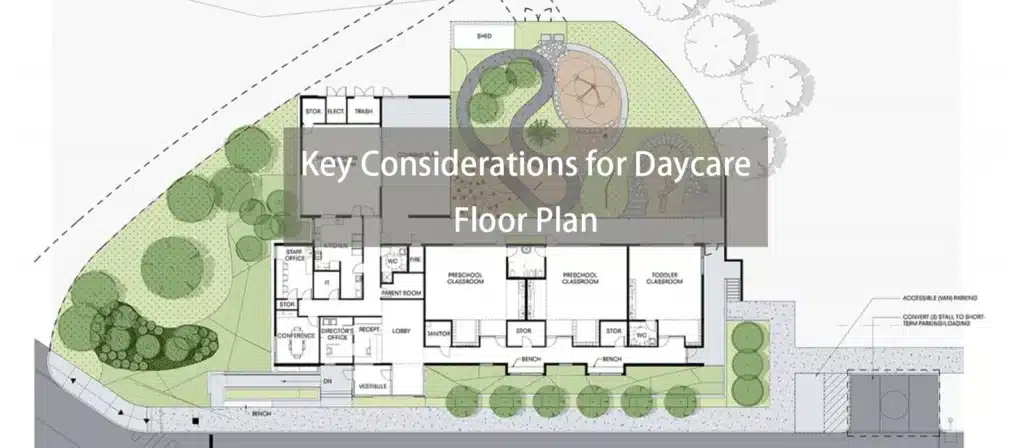
When designing a preschool floor plan, several key considerations must be considered. These include the children’s needs, the staff’s requirements, and the space’s practical aspects.
- Total number of children in classrooms
- Number of staff
- Total number of regular visitors
- Number of classrooms required
- Space required for staff
- Children’s needs
- Sufficient indoor space for activities
- Entrance/reception area
- Food preparation space
- Sufficient space for daycare outdoor equipment
- Storage space
- Set up different types of stations
- Behavior management space
- Amount of furniture and other materials
Daycare Floor Plan Layout Ideas
Innovative classroom layout ideas can transform a daycare center, making it a more effective and enjoyable space for children and staff. Here are some trending layout ideas.
Small Daycare Floor Plan
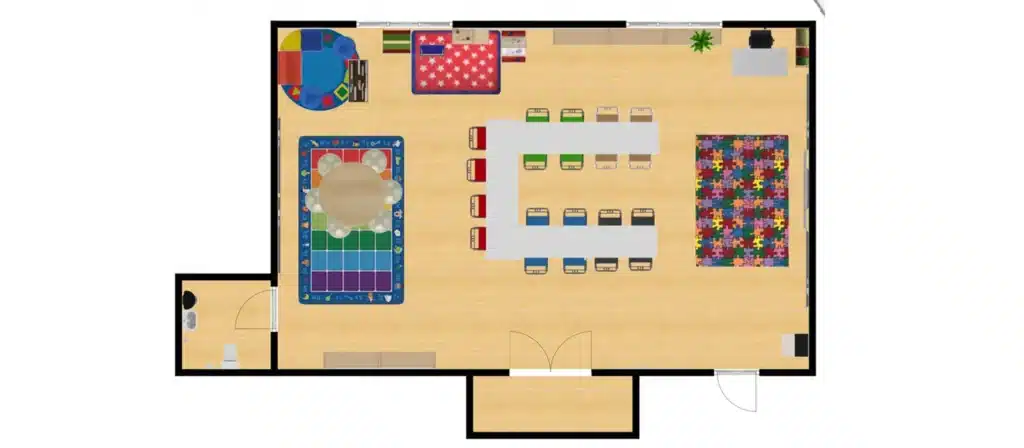
These programs usually serve 6 to 12 children, often across multiple age groups.
Key layout recommendations:
- Multi-use zones: Combine play, rest, and snack areas within the same room using mobile dividers or furniture.
- Vertical storage: Use wall-mounted bins, stackable units, and closet organizers to keep floor space clear.
- Open supervision: Avoid partitions that block line of sight. For example, low bookshelves can divide toddler play from infant rest areas without sacrificing visibility.
- Adjacent restrooms: Keep a child-sized toilet within or next to the main area to reduce transition time and supervision gaps.
- Drop-off space: Even in compact settings, create a clear entry path for parents—ideally with hooks or cubbies for child belongings.
A small daycare floor plan succeeds when it provides flexibility without feeling crowded. The goal is to make every square foot work harder while maintaining a welcoming, child-friendly atmosphere.
Medium Daycare Floor Plan
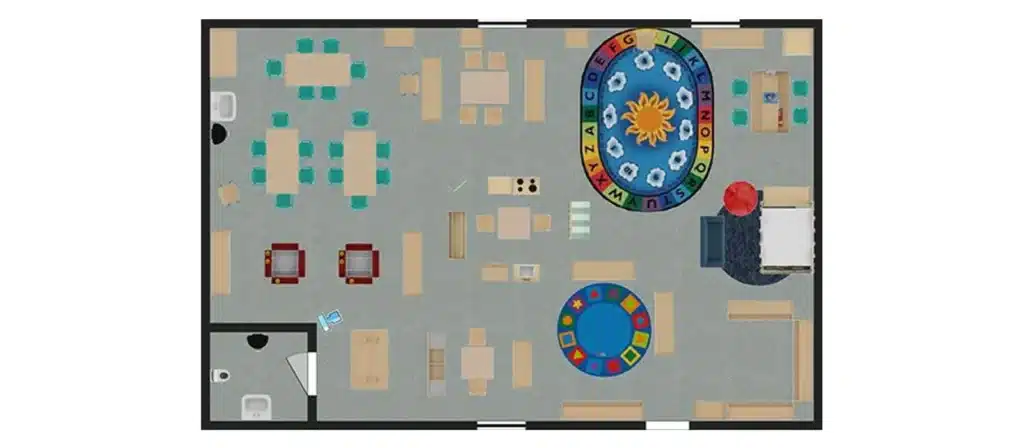
Medium-sized centers typically serve 20 to 50 children. These setups benefit from having dedicated classrooms by age group.
Key layout recommendations:
- Distinct classrooms: Separate rooms for infants, toddlers, and preschoolers to meet differing needs and comply with staff ratios.
- Central hallway or open flow: A hallway design works for segmented spaces; open floor concepts with clear zoning work when classrooms share square footage.
- Shared amenities: Include centralized bathrooms, food prep areas, and a staff planning room.
- Outdoor access: Whenever possible, allow direct classroom access to a fenced outdoor play space, especially for toddlers and preschoolers.
- Defined entry and reception area: A welcoming front desk with controlled access enhances security and supports parent engagement.
Medium daycare layouts should balance structure with flexibility. Your floor plan should make supervision easy, accommodate daily routines, and leave room for occasional mixed-age group activities.
Large Daycare Floor Plan
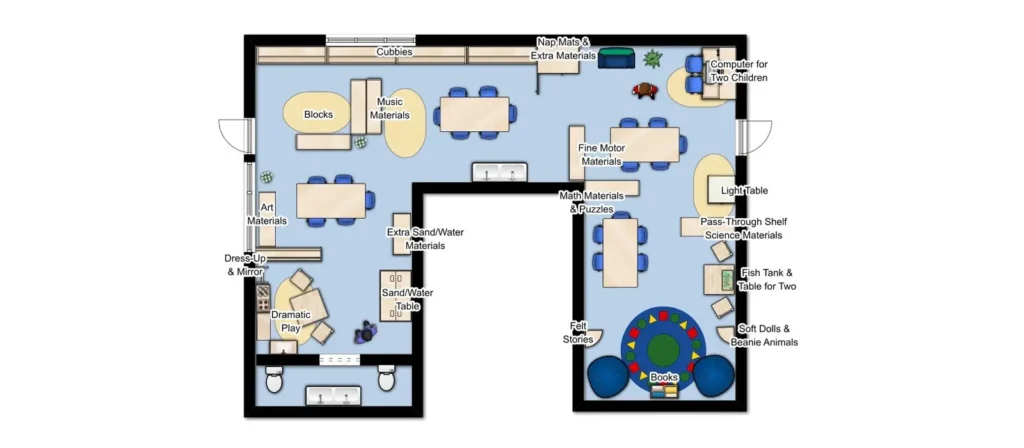
Large daycare facilities are typically permitted to accommodate 60 to 100 or more children. These facilities require more detailed layouts, divided by age, activity, and function.
Key layout recommendations:
- Age-segmented classroom wings: Infants, toddlers, and preschoolers should have separate wings or clusters, each with age-appropriate amenities.
- Specialty spaces: Include multipurpose rooms, sensory rooms, libraries, and indoor gross-motor play areas.
- Dedicated staff facilities: Staff lounges, private offices, training rooms, and supply storage improve retention and efficiency.
- Efficient traffic patterns: Wide hallways, staggered pickup zones, and logical flow reduce congestion during peak times.
- Technology integration: Plan for digital check-in stations, security systems, and classroom tech tools, with wiring and power needs addressed in the layout.
In large-scale operations, the floor plan must support high occupancy without sacrificing the individual care and learning environment that defines quality child care. Each space should feel intentional, not institutional.
Essential Areas in a Daycare Floor Plan
When you’re planning a daycare, it’s easy to focus on big-picture items like classroom sizes and outdoor play space. But the real heart of a great center lies in the details—those everyday spaces that make life easier for kids, teachers, and families. Here’s a look at the key areas every daycare should include, and why each one matters more than you might think.
- Reception and Registration Area:
This is where families walk in each morning, often juggling bags, bottles, and babies. The space needs to feel warm and secure, but also efficient. A desk for staff check-in, a place to store sign-in tablets or paper logs, and a view into the classrooms go a long way in making parents feel confident and welcomed. - Waiting Area:
Drop-off and pick-up don’t always happen like clockwork. A small area with a couple of chairs and some space for strollers gives parents a spot to pause. It’s also helpful when families need to chat with staff or wait during late pickups without crowding the main entry. - Storage Area:
Daycares need more storage than you think—extra bedding, seasonal clothes, rotating toys, art supplies, and emergency kits all need a place to go. Cubby systems work great in classrooms for daily kid gear, but don’t forget about centralized storage for larger or less-used items. - Changing Room:
If you’re caring for infants or toddlers, a changing area is a must. It doesn’t have to be fancy—just clean, practical, and close to where kids spend their time. Most centers include a changing table, nearby handwashing sink, and shelves stocked with wipes, gloves, and diapers. - Activity Area:
This is where the real magic happens—painting, block-building, dress-up, you name it. Good activity areas don’t have to be huge, but they should offer variety and be easy to supervise. Kids need freedom to explore, and teachers need to be able to see everything with a quick glance. - Sleep Area:
Nap time can be one of the most peaceful—or stressful—parts of the day depending on the setup. For infants, that means a quiet, darkened room with spaced-out cribs. For toddlers and preschoolers, mats or cots in a dim, calm area of the classroom work well. Keep it cozy, not cluttered. - Classroom Learning Area:
Structured learning might only take up part of the day, but it still needs a clear home base. Tables and chairs that fit small bodies, materials like pencils and books, maybe a whiteboard or felt board for group time—it doesn’t need to look like school, but it should feel like a space for growing minds. - Dining Area:
Meals can happen in a central dining room or right inside the classroom, depending on the size of the center. Either way, kid-sized tables and chairs, a handwashing station nearby, and surfaces that are easy to wipe clean are must-haves. Keep the vibe calm and organized to make meals enjoyable for everyone. - Toilets and Changing Tables:
These should be close to the action, especially for young children who are potty training. Bathrooms with low toilets and sinks encourage independence, while diaper stations near toddler rooms help staff handle quick changes without leaving the group. - Staff and Administrative Offices:
Teachers need a place to breathe, plan, and handle the behind-the-scenes tasks that keep things running. Even a small break room or quiet nook makes a difference. The director’s office or admin area should also be close to the front—where parents can pop in and paperwork stays organized.
Early childhood environment studies emphasise that children learn better in spaces that are predictable, clearly zoned, and easy to navigate. Designing indoor space as both a living and learning environment is recommended by The Education Hub (2020).

Daycare Floor Plan Examples
There’s no one right way to lay out a daycare. The best design depends on your space, your goals, and the families you serve. Some programs thrive in cozy home settings, while others run out of purpose-built facilities with room for dozens of children. Below are a few popular styles of daycare floor plans that providers across the U.S. often use—each with its own personality and strengths.
Traditional Room-Based Layout
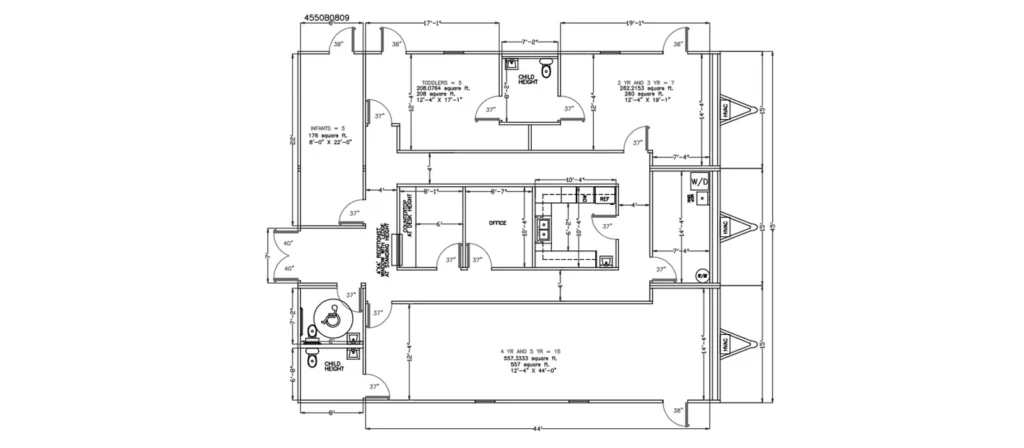
This is one of the most common and familiar daycare designs, especially in licensed centers that serve multiple age groups. In this layout, each classroom is completely enclosed, separated by full-height walls and doors. Infants, toddlers, and preschoolers each have their own space, often with dedicated bathrooms or changing areas attached.
It’s a practical choice for centers that value structure, quiet zones, and regulatory clarity. Having defined spaces makes it easier to manage staff-to-child ratios and age-appropriate activities. While it can limit flexibility, this setup works well in school-like settings or centers housed in larger commercial buildings.
Open Concept Floor Plan
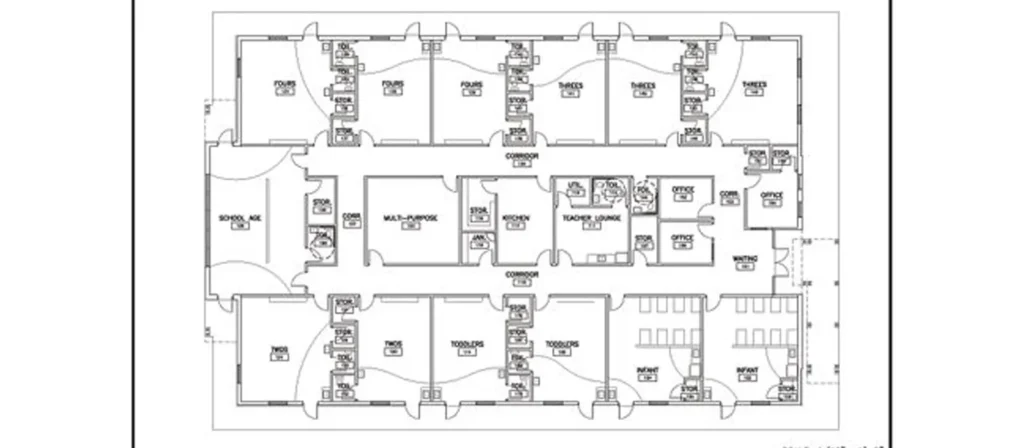
If your program values flexibility, shared learning, and transparency, an open concept layout might be the right fit. Instead of walled-off classrooms, the space is divided using furniture, rugs, or low partitions. Children move freely between different activity zones—like art, blocks, reading, or dramatic play—while staff can keep eyes on multiple areas from a central point.
This design works especially well for Montessori, Reggio Emilia, or other child-directed programs. However, it requires thoughtful planning to manage noise levels and transitions, and it’s not ideal in states where licensing requires strict room separation by age.
Pod-Style Layout
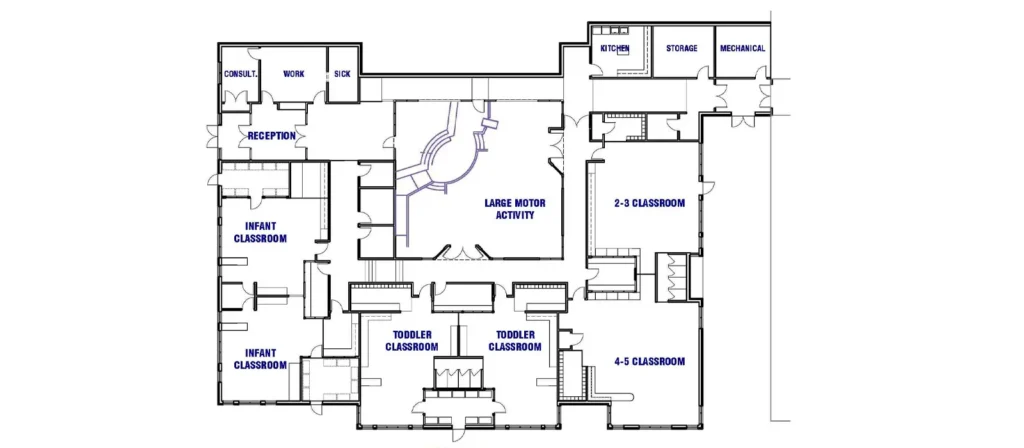
This design clusters classrooms into small “pods” by age group, each with its own mini restrooms, play areas, and entrances. It’s common in mid- to large-size programs where you want clear boundaries between infants, toddlers, and preschoolers but still want shared access to spaces like the kitchen or playground. This setup supports licensing compliance and keeps transitions smoother by age.
Home-Based or Family Childcare Layout
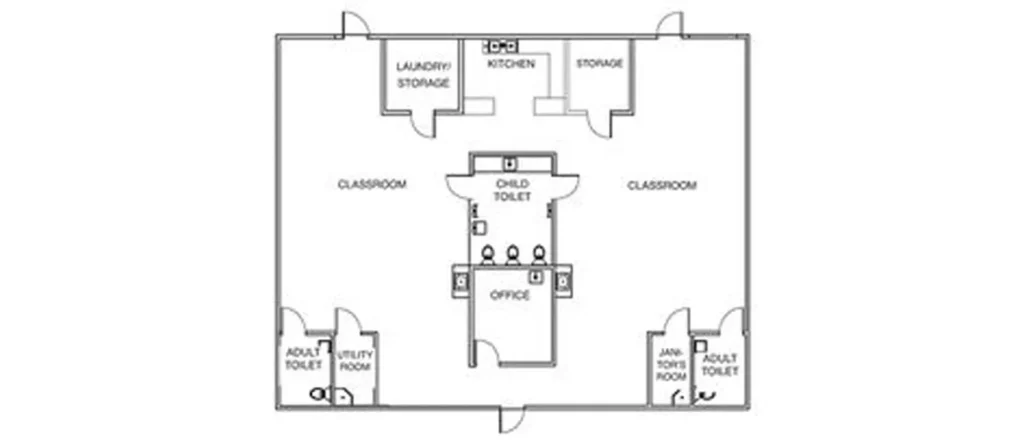
Home-based daycare programs (often referred to as “family childcare”) typically operate out of a provider’s residence and follow a much more intimate layout. A living room might be transformed into a multi-age playroom, while bedrooms become quiet nap spaces. Meals are often served at a kitchen table, and diapering areas are incorporated into the existing bathrooms.
Central Corridor Plan
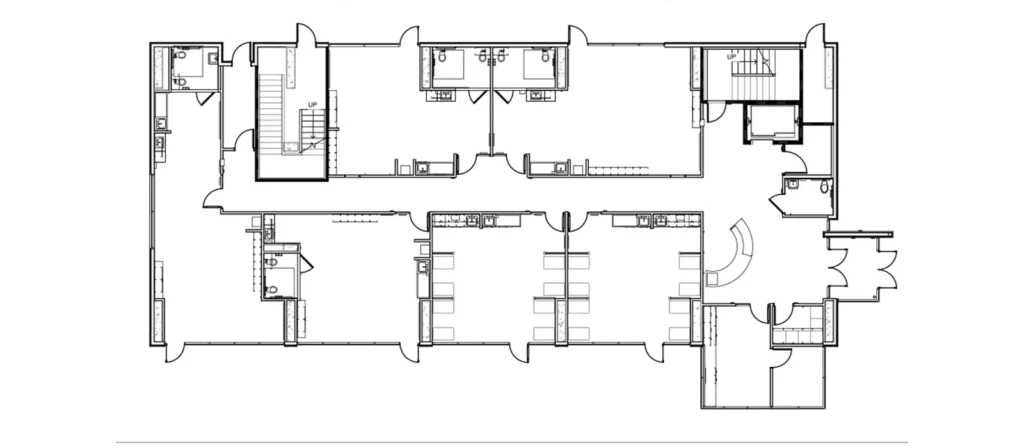
Often found in converted office buildings or churches, this layout features a central hallway with classrooms on either side. It’s efficient, easy to navigate, and gives each age group its own room. You’ll often find administrative offices near the entrance, with classrooms further back and direct exits to outdoor play areas.
Outdoor-Focused Design
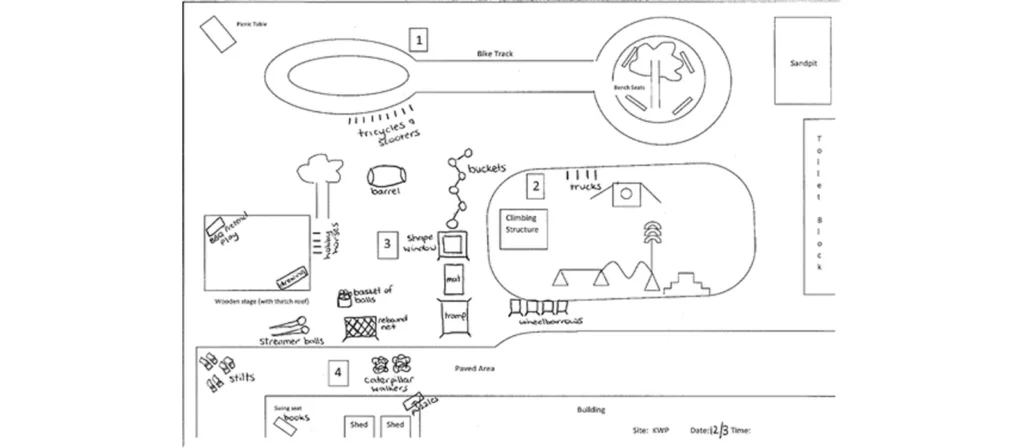
This floor plan centers around an outdoor courtyard or garden, with classrooms and activity zones built around it. It’s especially popular in areas with good weather year-round (like California or Arizona) or programs with a nature-based philosophy. The outdoor space becomes part of the learning environment rather than an add-on.
Inside, you’ll find mud sinks near exits, cubbies for outdoor gear, and floors that can handle wet shoes and messy play. These environments support gross motor development, sensory exploration, and environmental education. For many programs, especially those that embrace a “forest school” or “nature preschool” model, this layout isn’t just a style—it’s central to their mission.
Below Are Examples of Daycare Floor Plans That Were Designed.
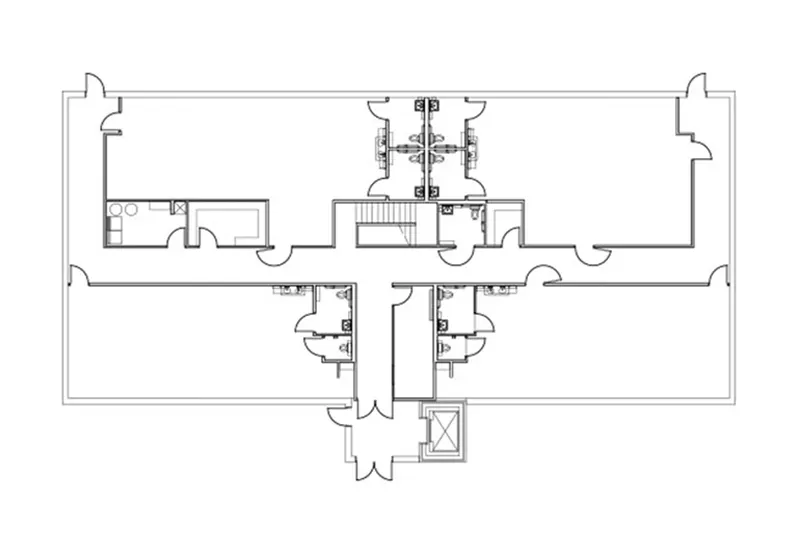
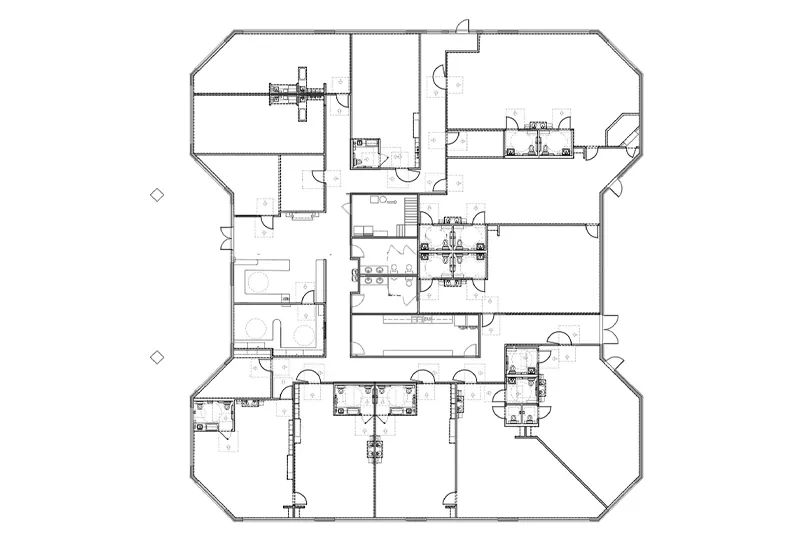
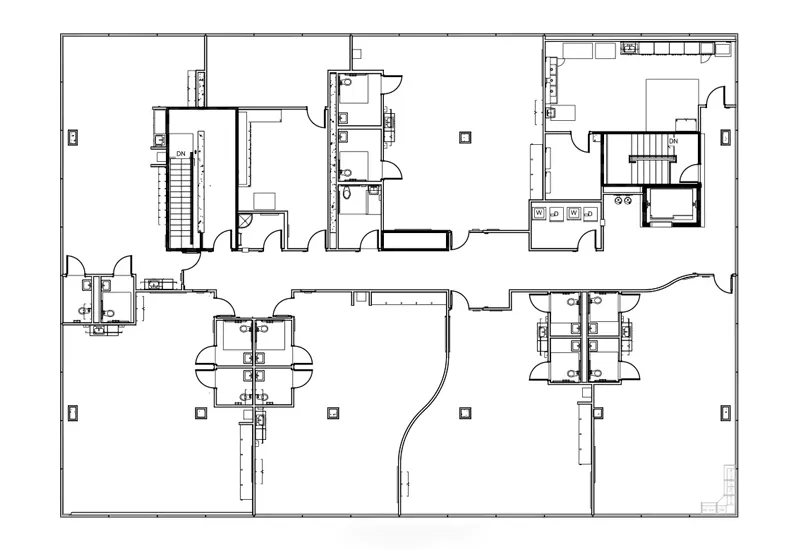
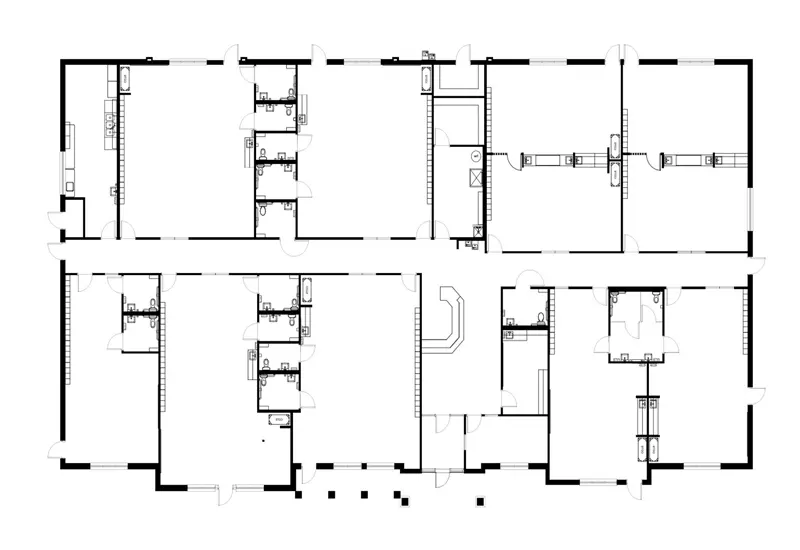
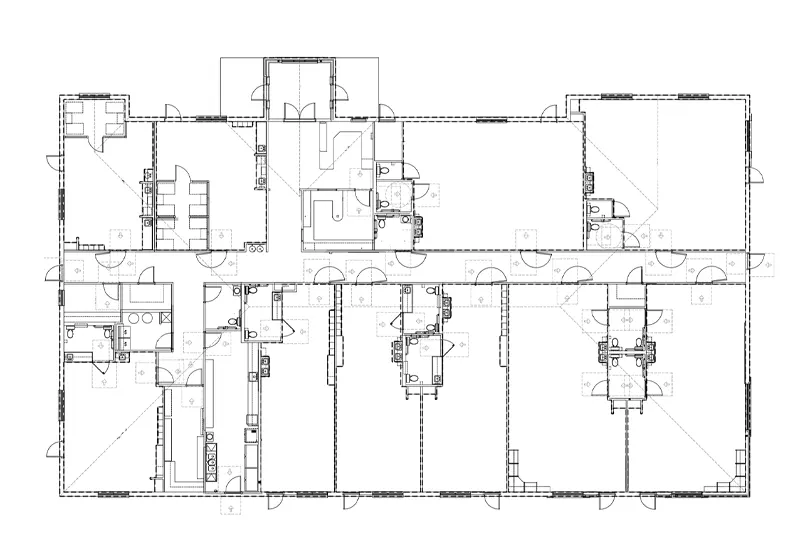
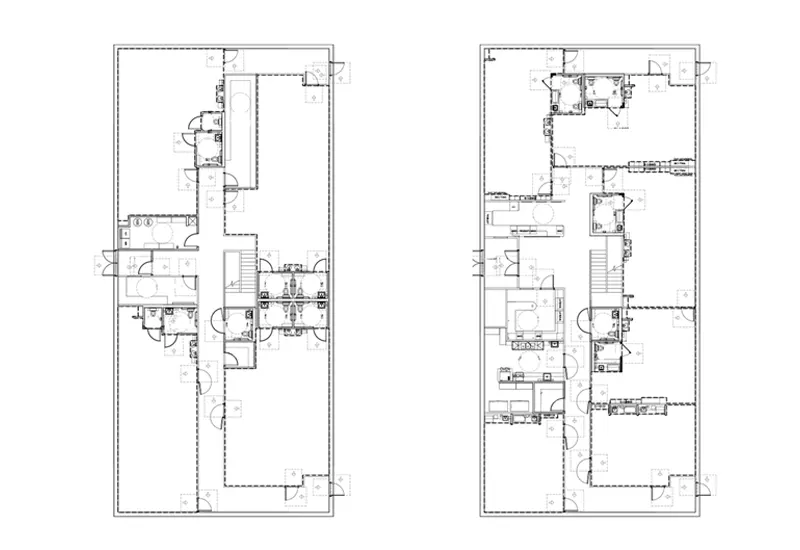
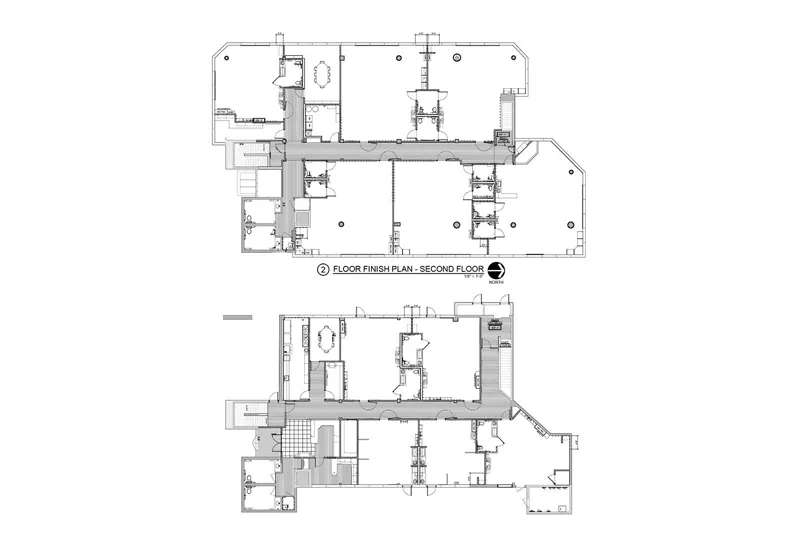
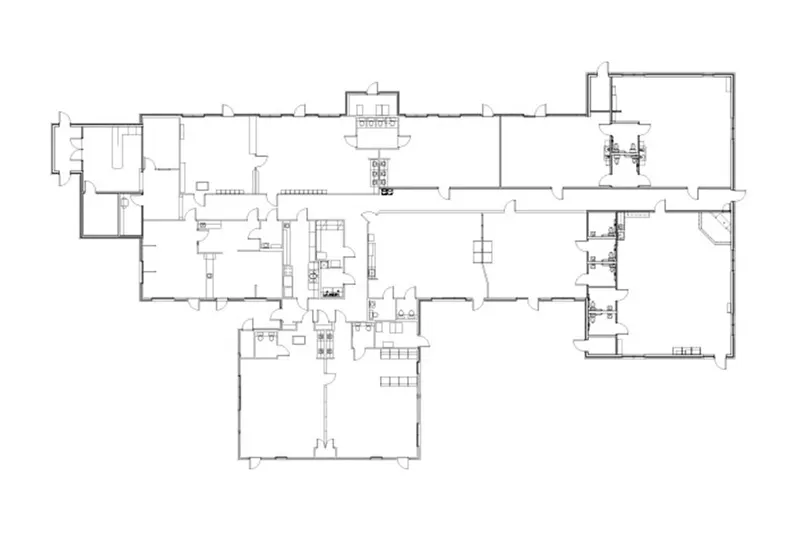
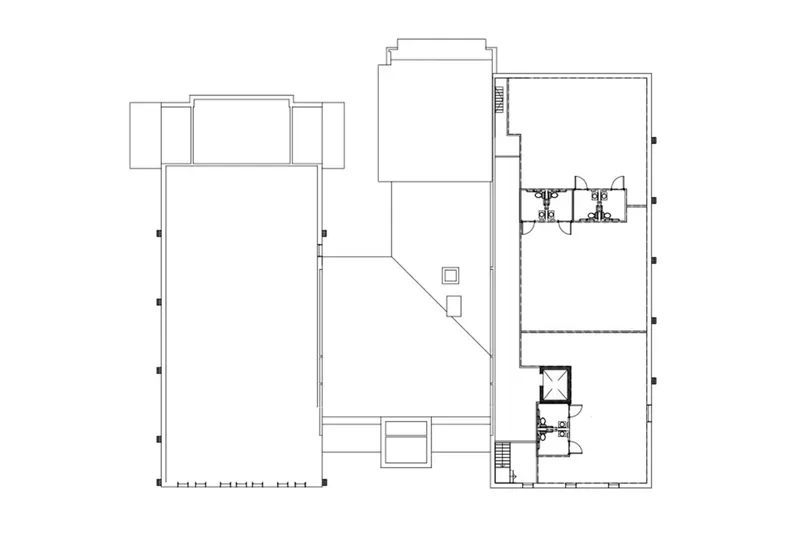


These examples can serve as a starting point for designing a daycare that meets the needs of children, parents and staff. Each program emphasizes safety, functionality and a stimulating environment that promotes child development.
If you would like more information about preschool floor plans, please get in touch with Xiha Montessori for more information.
Other Considerations for Designing a Daycare Floor Plan
Beyond aesthetics and functionality, your floor plan must serve your mission, comply with legal obligations, and leave room for long-term growth.
Project Needs Assessment
Before drawing a single line, answer:
- How many children do you plan to serve daily?
- What are the staff-to-child ratios required by your state?
- Will your center be for-profit, nonprofit, or part of a school system?
- Do you need multi-language or special needs accommodations?
These questions shape not just layout but zoning, staffing, furniture needs, and funding sources.
For instance, a Head Start center will have stricter classroom area requirements and inclusive features like family-style dining and dedicated parent spaces.
Legal and Safety Requirements
Every U.S. state has unique licensing standards for floor space, egress, staff restrooms, cleaning zones, diapering facilities, and more.
Common legal design needs include:
- Separate HVAC systems for food prep vs child play areas.
- Height-specific sinks and toilets for children under age five.
- One diaper-changing station per 8 infants, typically in an isolated yet supervised area.
- Storage for hazardous materials locked and out of children’s reach.
Your floor plan must be built with the licensing checklist in hand. Failure to comply often results in costly rework or denied operating permits.
Future Scalability Planning
Will you be serving the same number of children in 3 years?
Many centers underestimate their future needs. Designing with scalability in mind might include:
- Expandable classrooms that can be split or combined.
- Multipurpose rooms used for events, overflow, or new age groups.
- Modular furniture systems that shift with changing classroom demographics.
Some providers in suburban areas purchase adjacent land or lease extra rooms in anticipation of growth. Include expansion corridors or neutral shared areas in your plan if possible.
Accessibility and Inclusivity
Under the Americans with Disabilities Act (ADA), all child care facilities must offer equitable access. But great centers go beyond compliance.
Design inclusively with:
- Wide pathways for wheelchairs and strollers.
- Sensory-sensitive zones for children with autism or sensory processing needs.
- Gender-neutral restrooms with appropriate supervision.
- Visual guides for ESL learners or children with speech delays.
Final Checklist for a Daycare Floor Plan
Before finalising your Daycare Floor Plan, run through this checklist:
- Do you meet local licensing space‑per‑child and safety requirements?
- Is the zoning clear: reception, classrooms by age, rest/naps, play, outdoor, staff zones?
- Are sight‑lines to all key areas unobstructed?
- Are quiet zones separated from noisy zones?
- Is the drop‑off/pick‑up flow safe and efficient?
- Are the restrooms, storage, staff areas logically located and accessible?
- Is the furniture age‑appropriate and sized for children?
- Have you planned natural light, ventilation, and healthy environmental factors?
- Does the layout allow for flexibility and future adaptation?
- Have you incorporated inclusive design and accessibility?
- Is the budget realistic for furniture, finishes, and build‑out?
Running through this checklist ensures your Daycare Floor Plan is robust, thoughtful, and ready to support children, staff and families.
Frequently Asked Questions
1. Common Mistakes When Designing Daycare Floor Plans?
- Lack of childproofing
- Limited outdoor space
- No child-centered design
- No additional nap area
2. How Much Space Do You Need per Child in a Daycare Center?
This is the question that can make or break your licensing approval—and your daily operations.
State-By-State Minimum Requirements
While federal standards suggest 35 square feet of usable space per child, most U.S. states have specific numbers depending on age and usage.
Here’s a simplified breakdown for indoor space:
| Age Group | Minimum Square Feet per Child |
|---|---|
| Infants (0–18 mo) | 45–50 sq ft |
| Toddlers (18–36 mo) | 40–45 sq ft |
| Preschoolers (3–5 yrs) | 35–40 sq ft |
| Mixed-age groups | Varies by ratio and age mix |
Outdoor space is usually required at 75–100 square feet per child, depending on state regulations and whether the center operates full-day or part-day.
Some states, like Oregon or Washington, even mandate covered outdoor space for rainy weather conditions.
What Counts as Usable Space?
When calculating square footage, you must exclude:
- Bathrooms
- Hallways
- Closets
- Kitchen areas (unless part of teaching space)
- Staff lounges
Only the learning and child activity areas count.
For example, if your classroom is 600 square feet but 150 square feet is used for storage and traffic, only 450 sq ft is considered usable—enough for 12 preschoolers at 35 sq ft each.
Special Considerations
- Sleeping Area for Infants: Separate space is often required, with specific guidelines for cribs and spacing between them. At least 2-3 feet of space around each crib to allow for easy movement and access.
- Activity Rooms: Art, reading, and play areas should be designed to accommodate the specific needs of the age group.
- Eating Area: For a group of 20 children, you would need approximately 200-300 square feet, ensuring enough space for tables, chairs, and movement around the area.
- Bathrooms: Each toilet and sink should have at least 15-20 square feet for comfortable use and supervision.
- Art area: Typically, you might allocate about 100-150 square feet for an art area, depending on the number of children and planned activities.
- Reading corner: A cozy reading corner can be about 50-75 square feet, providing plenty of room for small bookshelves, cushions, and bean bags.
- Play Area: Depending on the size of the group, a play area may range from 150-300 square feet to allow for various activities and equipment.
What Daycare Floor Plan Creators Are There?
There are several software tools and platforms available that can help you create kindergarten floor plans. Here are some popular options:
1. RoomSketcher

- Features: Easy-to-use interface, drag-and-drop functionality, 3D visualization, and customization options.
- Use: Ideal for creating detailed floor plans, including furniture and equipment placement.
2. SmartDraw

- Features: Comprehensive library of symbols, templates, and integration with other tools like Microsoft Office and Google Workspace.
- Use: Suitable for both beginners and professionals to create detailed and professional-looking floor plans.
3. SketchUp

- Features: 3D modeling capabilities, extensive library of pre-designed components, and powerful design tools.
- Use: Great for creating highly detailed and customizable 3D floor plans, but may have a steeper learning curve.
4. Floorplanner

- Features: User-friendly interface, extensive furniture library, and ability to create 2D and 3D floor plans.
- Use: Perfect for quickly designing and visualizing floor plans with various customization options.

At Xiha Montessori, customized and comprehensive solutions are provided to meet the unique needs of daycare centers through specialized preschool furniture manufacturing and supply services. Services include detailed floor plan design, classroom layout planning, and customized furniture manufacturing to ensure a seamless and efficient process from concept to delivery. The one-stop shop simplifies the journey for the client, enabling them to realize their ideal classroom setup effortlessly.
6. HomeByMe
- Features: 3D rendering, realistic visualization, and community gallery for inspiration.
- Use: Ideal for creating and visualizing detailed floor plans and getting inspiration from other users’ designs.
7. Planner 5D

- Features: Intuitive drag-and-drop editor, 2D and 3D viewing modes, and large object library.
- Use: Suitable for creating attractive and detailed floor plans without needing advanced design skills.
What learning corners and related products should be included in a daycare floor plan?
A Montessori-inspired daycare floor plan should integrate diverse, purpose-driven learning corners to encourage independence, concentration, and exploration:
Practical Life Area – Child-sized tables, chairs, trays, and cleaning tools to develop self-care and motor skills.
Reading Nook – Low open bookshelves, cozy sofas, soft carpets, or a tree-shaped bookshelf for easy book access and a love of reading.
Sensorial Corner – Textured rugs, sorting materials, and tactile manipulatives to refine sensory perception.
Art & Creativity Zone – Easels, drawing tables, and organized art supplies for self-expression.
Nature Study Area – Indoor plants, observation tables, and magnifying tools to connect children with the natural world.
Each space should be furnished with safe, ergonomic, and age-appropriate materials to align with Montessori’s emphasis on freedom of movement, choice, and hands-on learning.
Conclusion
Daycare floor plans combine safety, flexibility, and creativity to create nurturing environments. By integrating open space, natural light, multi-functional areas, and innovative safety features, these designs set a new standard for daycare centers. When we embrace these trends, we can ensure that our daycare centers provide the best possible environment for children to grow and develop.
References
Barrett, P., Davies, F., Zhang, Y., & Barrett, L. (2015). The impact of classroom design on pupils’ learning: Final results of a holistic, multi-level analysis. Building and Environment, 89, 118-133.
Fardlillah, M., & Suryono, Y. (2019). Physical environment classroom: Principles and design elements of classroom in early childhood education. Jurnal Obsesi.
The Education Hub. (2020). Designing indoor spaces for living and learning in early childhood education.
Child Care Now. (2025). Why the physical environment matters in child care – Spotlight report.
Deng, S. (2024). An eco-psychological framework for research on the physical environment of children.
Colbert, J. (2006). Classroom design and how it influences behavior. Community Playthings.
Mealings, K., Demuth, K., Buchholz, J. M., & Dillon, H. (2015). Investigating the acoustics of a sample of open plan and enclosed kindergarten classrooms. Applied Acoustics.












